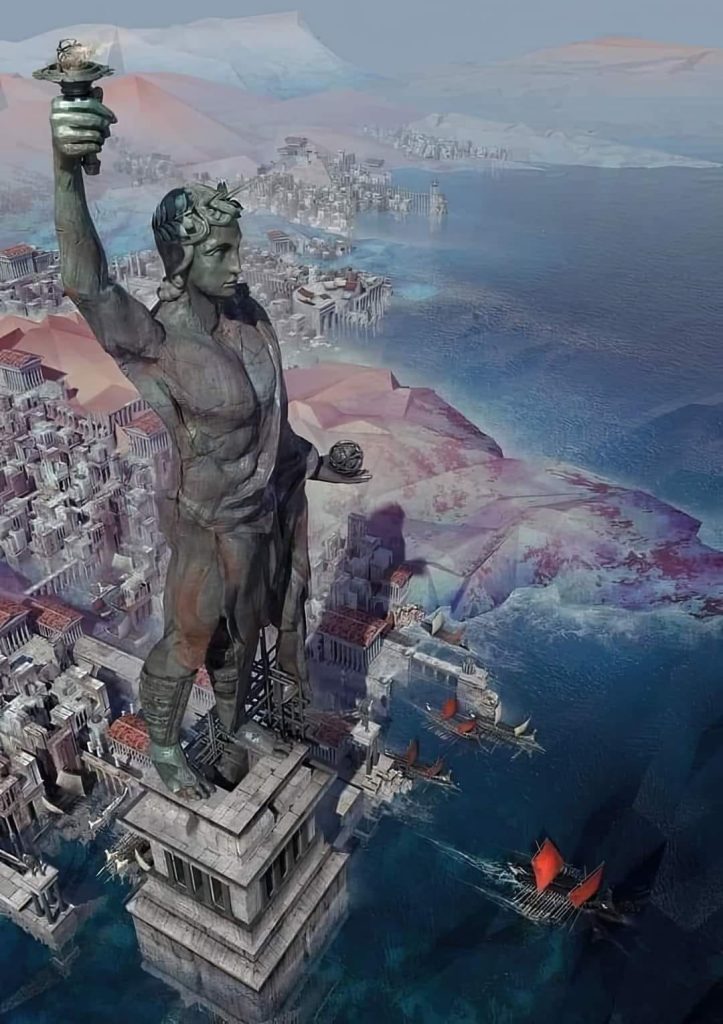Standing tall at the entrance of Mandraki Harbor on the Greek island of Rhodes, the Colossus of Rhodes was far more than a statue. It was a towering embodiment of ancient Greek brilliance, both a symbol of triumph and a marvel of innovation. At an astonishing height of 157 feet, the Colossus earned its place among the Seven Wonders of the Ancient World and captured the imagination of generations to come.

The Colossus was constructed between 292 and 280 BCE by the renowned sculptor Chares of Lindos. It was dedicated to Helios, the Greek god of the sun, in gratitude for the island’s successful defense against an invasion by Demetrius I of Macedon. After a long siege that lasted over a year, the people of Rhodes emerged victorious. To celebrate this military success, they decided to build a grand monument to honor their patron deity. Funded by selling off the abandoned war equipment left behind by the defeated army, the statue was not just a religious offering—it was a declaration of strength, unity, and technical advancement.
Building the Colossus required remarkable ingenuity. Ancient Greek engineers faced daunting challenges, particularly in managing the size and weight of the structure. Primarily made from iron and brass, the statue’s internal framework was filled with stone blocks to add stability and resist the forces of nature. Earth mounds were used to gradually elevate workers alongside the rising figure, a technique that showed the Greeks’ cleverness in problem-solving long before the invention of modern machinery. Piece by piece, the components were raised and joined together with meticulous care. The use of hammered brass plates over a robust iron framework was a demonstration of engineering mastery for its time.
Once completed, the Colossus stood like a sentinel at the harbor’s entrance, embodying the spirit of Rhodes. For 54 years, it served not only as a monumental guardian but also as a potent symbol of Rhodes’ naval dominance, economic prosperity, and religious devotion. It is believed that ships passed beside the statue as they entered the harbor, awestruck by the sheer scale and grandeur of the monument. Although later artistic interpretations suggest that the statue straddled the harbor entrance, this image is now considered more mythical than factual. Historical accounts suggest that the Colossus stood on a single side of the harbor, elevated on a stone pedestal to maximize visibility.
Despite its brief lifespan, the Colossus became an icon of the ancient world. However, in 226 BCE, just over half a century after its completion, tragedy struck. A powerful earthquake rocked Rhodes, and the colossal statue, unable to withstand the intense tremors, snapped at the knees and crumbled to the ground. The once-glorious monument lay in ruins, its fallen pieces a stark reminder of nature’s ability to humble even the greatest of human creations.
Surprisingly, the people of Rhodes chose not to rebuild the statue. Although devastated by its collapse, they heeded the words of an oracle who warned that rebuilding the Colossus could invite misfortune. Whether this decision stemmed from religious fear, practical constraints, or shifting priorities, the broken pieces were left untouched for centuries. Even in ruin, the remains attracted visitors from around the ancient world. Tourists traveled to Rhodes just to witness the remnants of the fallen wonder, still impressed by its scale and craftsmanship.
To this day, the precise location of the Colossus remains an unresolved puzzle. Despite various archaeological efforts and historical speculation, no definitive evidence has been found to pinpoint its original site. Some scholars argue that fragments may still be buried beneath modern Rhodes or hidden underwater near the harbor. Others believe the materials were long ago repurposed or lost to time. This uncertainty has only fueled the legend of the Colossus, adding a layer of mystery that continues to fascinate historians, archaeologists, and travelers alike.
What cannot be disputed, however, is the Colossus’s lasting legacy. Although it no longer towers over the harbor, its story endures as a powerful example of human creativity, resilience, and ambition. As one of the Seven Wonders of the Ancient World, the Colossus continues to captivate the human imagination. It symbolizes the remarkable capabilities of ancient civilizations to dream big and execute those dreams with limited tools and knowledge, often achieving results that still astonish modern experts.
The Colossus of Rhodes represents more than a physical monument—it reflects a moment in history when art, faith, and engineering converged to create something extraordinary. It reminds us that the human spirit is capable of great things, especially when driven by a shared sense of purpose and pride. Though the bronze giant has vanished from the earth, its story lives on, echoing across centuries as a testament to what ancient people could achieve with vision and determination.
In a world where technology often dominates conversations about innovation, the tale of the Colossus serves as a humbling reminder that progress isn’t a modern invention. Long before computers or cranes, people found ways to build the impossible. They looked to the skies, honored their gods, and dared to leave something lasting behind. The Colossus may have fallen, but the inspiration it offers stands unshaken—encouraging future generations to aim high, work together, and create with courage.
The story of the Colossus of Rhodes is ultimately a story of vision, strength, and endurance. It teaches that even when greatness collapses, the memory of what was once achieved can continue to shape the course of human ambition. In every attempt to build, discover, or push boundaries, there echoes the spirit of that ancient marvel standing watch over the Aegean Sea.





